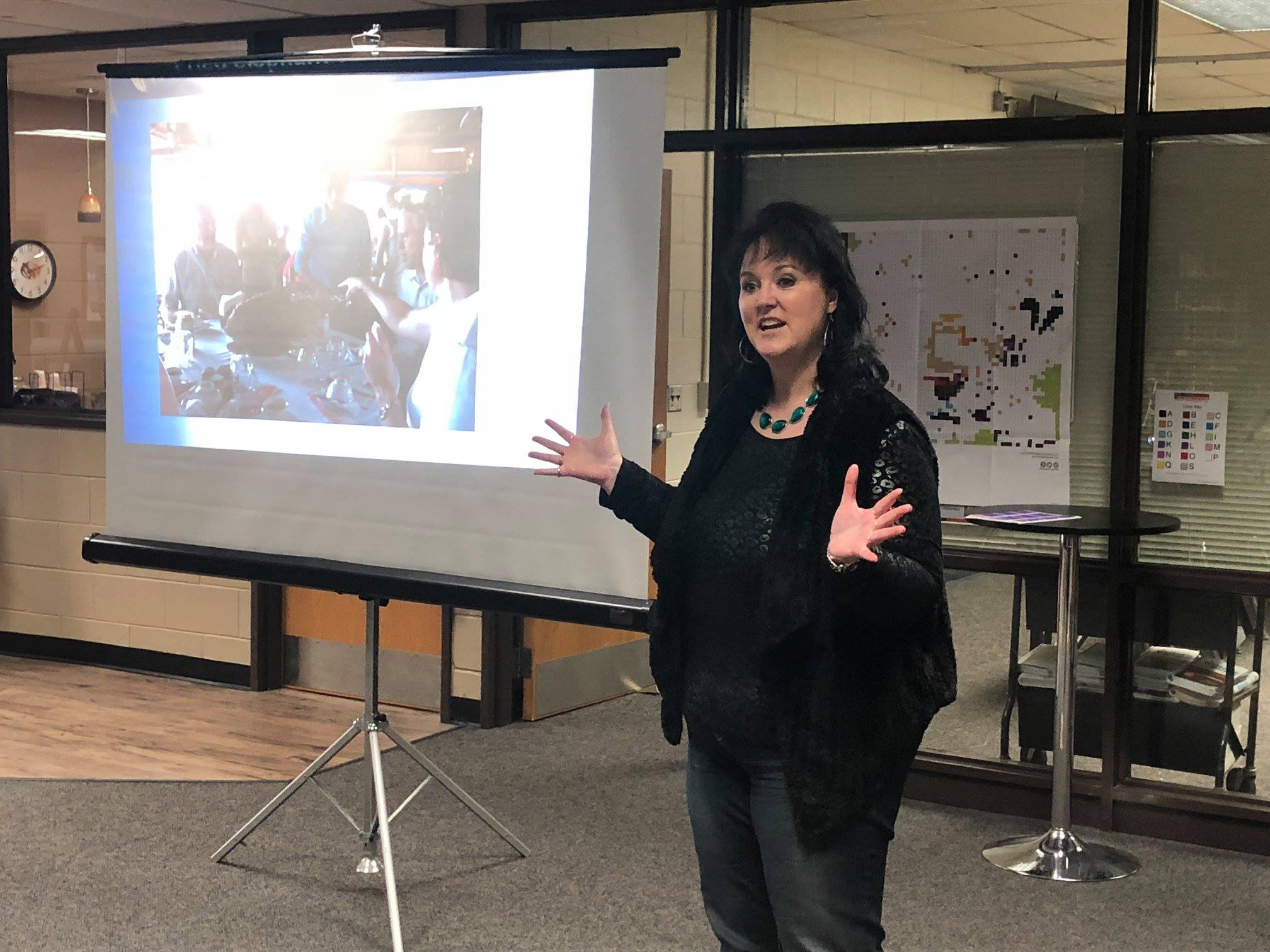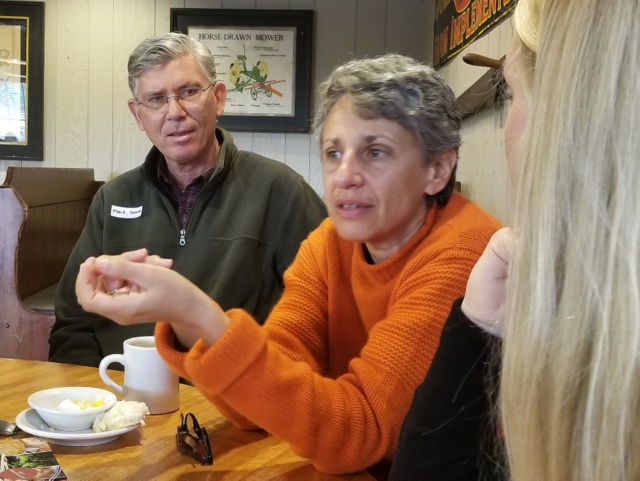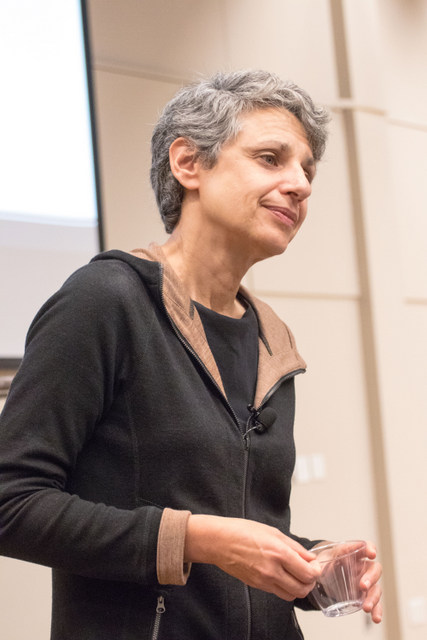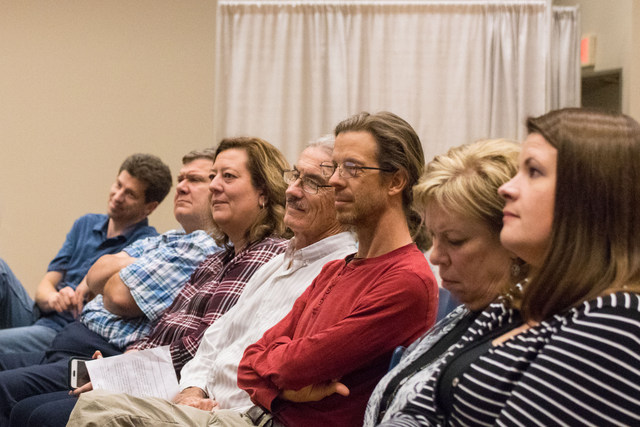Category: writing

Why We Should Never Stop Asking Why
Ever been asked to speak at career day at the local middle school? If you haven’t, trust me when I say it’s an eye-opening, slightly nerve-wracking experience.
I volunteered with the Calhoun County Farm Bureau to speak at Ag Day on March 26 at the Manson Northwest Webster Middle School about my travels to Vietnam and South Korea a few years ago with the Iowa Corn Growers’ I-LEAD leadership group.
Then I headed west to Sac City on March 29 to share my “True Confessions of an Ag Journalist” program during the Sac County Farm Bureau’s I Am Ag career day, where professionals from veterinarians to bankers spoke about the pros and cons of their careers.
Throughout the day, each speaker is assigned a classroom, and we share our story 12 times in 25-minute segments. I always go home from these events exhausted, but I hope I added value for the students and helped spark their desire to keep learning.
What always amazes me is how different the response is from the sixth graders to the eighth graders. The sixth graders are excited to learn and have no fear of asking questions. In fact, many of them are quick to raise their hands to ask questions and share comments.
Everything changes when the eighth graders walk in the room. Many of these kids want to show you just how bored they are. Some convey clearly through their body language and comments that don’t want to be stuck in a classroom. Their eyes tell you in no uncertain terms that they’re just waiting to defy anyone who dares to challenge them to think and learn.
Undaunted, I tell every group of students I work with that one of the keys to being a successful writer/storyteller/journalist (or any leader, for that matter) is to be like the little kid who never stopped asking why. Always nurture your sense of wonder and curiosity. Not only is that how we learn, but it makes life more fun!
Why do we lose the why?
This experience made me wonder why so many people lose their desire to ask questions.
A Newsweek story, “The Creativity Crisis,” described the signs of declining creativity among our school children. The article noted that preschool kids ask their parents an average of 100 questions a day. WOW! By middle school, however, kids basically stop asking questions.
It is also around this time student motivation and engagement drop like a rock. Why? Our educational system tends to reward students for having the answer, not for asking good questions. Ask a question, and you risk looking ignorant.
Yet knowing how to ask the right questions in the right way is essential to career success, more enjoyable conversations, stronger interpersonal relationships and effective leadership. I can only tell compelling, clear stories for my clients and through my books when I ask the right questions.
 Questions I use
Questions I use
I often work from a tried-and-true, proven set of open-ended questions that encourage sources to open up so we can go beyond the superficial and dig deeper to get to the good stuff—the defining moments, the setbacks, and the dreams that add life and vitality to any story.
Here are some of my key questions
1. What’s some of the best business advice—or advice for life—you’ve ever received?
2. What’s your motivation (for your work, or your life)?
3. What three things inspire you? (These can be people, books, movies, art, places, etc.)
4. What three words describe you?
5. What three words describe your company?
6. What’s something odd/interesting/unique about you? (This fun fact should not be so personal you would only share it with a therapist, but also not so safe it will bore us!)
7. How did you get started in the business you’re in?
8. Think back to when you first hit adulthood. What did you think your life would be like? What was your plan A? Are you still with Plan A, or did you move on to Plan B?
9. What obstacles did you overcome to get where you are today?
10. What’s a specific story of success in your business that drives you to do what you do? (A customer that really affected you, a person you were able to help, an accomplishment you were able to achieve?)
11. What do you like about your work?
12. What helpful lessons did you learn from previous jobs that you apply to your current role?
13. What’s the weirdest thing that’s ever happened to you at work?
14. What’s the best thing that ever happened to you/you witnessed at work?
15. How did your company get started?
16. What excites you about the future?
You can modify these questions (or create your own) and put them to work in your business, your home or your classroom. Please tell me how it goes, too. Don’t be surprised if I ask you why you think these questions work. I love to learn and hope you do to, too!
No matter what, never stop asking “why” about the world around you. We need more critical thinkers. Also remember the words of playwright George Bernard Shaw: “Some men see things as they are, and ask why. I dream of things that never were, and ask why not.”
Want more?
Thanks for stopping by. I invite you to read more of my blog posts if you value intriguing Iowa stories and history, along with Iowa food, agriculture updates, recipes and tips to make you a better communicator.
If you like what you see and want to be notified when I post new stories, be sure to click on the “subscribe to blog updates/newsletter” button at the top of this page, or click here. Feel free to share this with friends and colleagues who might be interested, too.
Also, if you or someone you know could use my writing services (I’m not only Iowa’s storyteller, but a professionally-trained journalist with 20 years of experience), let’s talk. I work with businesses and organizations within Iowa and across the country to unleash the power of great storytelling to define their brand and connect with their audience through clear, compelling blog posts, articles, news releases, feature stories, newsletter articles, social media, video scripts, and photography. Learn more at www.darcymaulsby.com, or e-mail me at yettergirl@yahoo.com.
If you’re hungry for more stories of Iowa history, check out my top-selling “Culinary History of Iowa: Sweet Corn, Pork Tenderloins, Maid-Rites and More” book from The History Press. Also take a look at my latest book, “Dallas County,” and my Calhoun County” book from Arcadia Publishing. Both are filled with vintage photos and compelling stories that showcase he history of small-town and rural Iowa. Order your signed copies today! Iowa postcards are available in my online store, too.
Let’s stay in touch. I’m at darcy@darcymaulsby.com, and yettergirl@yahoo.com.
Talk to you soon!
Darcy
@Copyright 2019 Darcy Maulsby & Co. Blog posts may only be reprinted with permission from Darcy Maulsby.

A Dirty Tip to Make Your Social Media Content More Shareable
Tire turd (noun): Wad of snow, ice, salt and gravel that piles up behind each vehicle tire in the winter. Removable only with explosives. #Iowa #winteriniowa
That’s a recent Facebook post I created when was in Red Oak, Iowa, this week, working on a newsletter for United Farmers Cooperative. When I stopped at the grain elevator, I saw this tire turd on my car. I decided to share it on my personal Facebook page. This silly post apparently struck a chord, because it has been liked 159 times, generated 23 comments and has been shared 17 times. Crazy!
This reminds me of one of the principles I teach in my storytelling classes. Shareability is a key to the most successful social posts.
People don’t just share any old content. Facebook reports that 0.5% of those who see a Facebook post share it. Of all the content links the average Twitter user receives, the re-tweet ratio is 1:318, according to one of my favorite books, “The Content Code,” by Mark Schaeffer.
Research sponsored by the New York Times found that people share content to:
• To be useful, since the info. is practical or timely
• To define themselves to others (look smarter, funnier, more relevant)
• To strengthen relationships with others
• Get the word out about causes, brands, events, etc. they care about
Think about the last time you shared something. What motivated you to do this?
How could you frame your stories and information to make your content more shareable?
Want more?
Thanks for stopping by. I invite you to read more of my blog posts if you value intriguing Iowa stories and history, along with Iowa food, agriculture updates, recipes and tips to make you a better communicator.
If you like what you see and want to be notified when I post new stories, be sure to click on the “subscribe to blog updates/newsletter” button at the top of this page, or click here. Feel free to share this with friends and colleagues who might be interested, too.
Also, if you or someone you know could use my writing services (I’m not only Iowa’s storyteller, but a professionally-trained journalist with 20 years of experience), let’s talk. I work with businesses and organizations within Iowa and across the country to unleash the power of great storytelling to define their brand and connect with their audience through clear, compelling blog posts, articles, news releases, feature stories, newsletter articles, social media, video scripts, and photography. Learn more at www.darcymaulsby.com, or e-mail me at yettergirl@yahoo.com.
If you’re hungry for more stories of Iowa history, check out my top-selling “Culinary History of Iowa: Sweet Corn, Pork Tenderloins, Maid-Rites and More” book from The History Press. Also take a look at my latest book, “Dallas County,” and my Calhoun County” book from Arcadia Publishing. Both are filled with vintage photos and compelling stories that showcase he history of small-town and rural Iowa. Order your signed copies today! Iowa postcards are available in my online store, too.
Let’s stay in touch. I’m at darcy@darcymaulsby.com, and yettergirl@yahoo.com.
Talk to you soon!
Darcy
@Copyright 2019 Darcy Maulsby & Co. Blog posts may only be reprinted with permission from Darcy Maulsby.

Could Your Story Change Someone’s Life?
Are you a gambler? I’m not. I’ve never even bought a lottery ticket. Maybe it’s because I grew up on a farm. (I learned early on that farming is enough of a gamble—no casino needed!)
Perhaps that’s why I wasn’t listening too closely to a discussion on talk radio recently about online sports betting. It’s a sure bet that sports wagering will be debated this year in the Iowa Capitol.
I was listening to show off and on as I wrote a question-and-answer feature about how FFA influenced Iowa Secretary of Agriculture Mike Naig’s career. The gambling debate wasn’t on my mind—until a story suddenly broke through and froze my fingers on the keyboard.
The radio show’s guest, Tom Coates, told the story of a woman who had called his family’s business, Consumer Credit of Des Moines, when she was caught in the strangling grip of a gambling addiction. Her ordeal had become so overwhelming, so costly and so shameful that she felt she was out of options—other than ending it all.
When she was driving home one night, she decided this was it. She was going to crash her car and end her life. For someone so consumed with despair, it made sense to her.
It just so happened that she had her car radio on during that fateful trip, however. A commercial from Consumer Credit caught her attention. Through a combination of the right message delivered in the right channel at the right time to the right audience, this simple ad (and maybe a serious jolt of divine intervention), stopped this woman from following through with her deadly plan.
She drove to a nearby gas station (this was in the days before everyone had a cell phone) and called Consumer Credit, Iowa’s largest credit counseling service. Consumer Credit’s message of helping people in financial trouble solve their debt problems touched something deep inside her. By dialing the phone, she received the help she needed.
Thanks to a simple radio ad, this woman’s story had a much happier outcome than it could have.
Cutting through the clutter–4 key takeaways
While the stakes usually aren’t this high with most messages we share, that doesn’t mean our stories don’t matter. You will cut through the clutter of this noisy world when you 1.) add value by offering a solution for your audience, 2.) speak human, 3.) strike an emotional chord, and 4.) share your stories consistently through a variety of channels.
You just never know which story or which communication method will connect with the people you’re trying to reach. That’s why it pays to try a variety of formats, from online channels to print publications to audio or video.
Will you be top of mind when someone needs to hear your story? Never underestimate the power of a true story well told. Your story might just matter to someone more than you know.
Want more?
Thanks for stopping by. I invite you to read more of my blog posts if you value intriguing Iowa stories and history, along with Iowa food, agriculture updates, recipes and tips to make you a better communicator.
If you like what you see and want to be notified when I post new stories, be sure to click on the “subscribe to blog updates/newsletter” button at the top of this page, or click here. Feel free to share this with friends and colleagues who might be interested, too.
Also, if you or someone you know could use my writing services (I’m not only Iowa’s storyteller, but a professionally-trained journalist with 20 years of experience), let’s talk. I work with businesses and organizations within Iowa and across the country to unleash the power of great storytelling to define their brand and connect with their audience through clear, compelling blog posts, articles, news releases, feature stories, newsletter articles, social media, video scripts, and photography. Learn more at www.darcymaulsby.com, or e-mail me at yettergirl@yahoo.com.
If you’re hungry for more stories of Iowa history, check out my top-selling “Culinary History of Iowa: Sweet Corn, Pork Tenderloins, Maid-Rites and More” book from The History Press. Also take a look at my latest book, “Dallas County,” and my Calhoun County” book from Arcadia Publishing. Both are filled with vintage photos and compelling stories that showcase he history of small-town and rural Iowa. Order your signed copies today! Iowa postcards are available in my online store, too.
Let’s stay in touch. I’m at darcy@darcymaulsby.com, and yettergirl@yahoo.com.
Talk to you soon!
Darcy
@Copyright 2019 Darcy Maulsby & Co. Blog posts may only be reprinted with permission from Darcy Maulsby.

6 Ways to Motivate Yourself to Write—Even When You’re Not in the Mood
Seems like hardly a week doesn’t go by when someone asks me about how to get published or how to muster enough discipline to write in the first place. Since I think I have a touch of attention-deficit/hyperactivity disorder (ADHD), I rely on 6 methods that may seem a bit unorthodox, but they work. (By the way, they also work for other areas of your life, not just writing.)
1. Think in terms of wealth. Your discipline will begin to kick in the moment you embrace the idea that writing is the basis of all wealth. This may or may not mean monetary wealth. Depending on the project, wealth might mean a paycheck. In other cases, wealth might mean sharing valuable ideas that help others, or simply enjoying the therapeutic process of putting ideas in a tangible form.
2. Call b.s. on writer’s block. Trust me—writer’s block is a myth. It doesn’t exist. Writing is an extension of thinking, so if you’re struggling, it’s not writer’s block; it’s thinker’s block. Stop blaming your lack of creativity and productivity on some mysterious, external force over which you have no control.
3. Prime the pump. If you have thinker’s block (and I definitely do from time to time), you’re not reading enough. You’re not listening enough. You’re not asking enough questions. You’re not making time every day to think. You’re not feeding your curiosity. Develop a mindset to perpetually hunt for insight. Even if I only have a few minutes to read each day, I explore everything from content marketing books to non-fiction history to biographies of serial killers—whatever strikes my fancy. Not only does this spark my motivation to write, but it helps me collect stories, catchy phrases, quirky quotes and memorable metaphors. I save all these gems in a “swipe file” (a basic, simple Word document) that I tap into to jump start the writing process.
4. Chill out and rest. I’m the first to admit I’m horrible at this. I’m trying to do a better job of getting my full 9 hours of sleep a night for greater focus and mental alertness during the day. (Yep, my body does best with 9 hours. Your body will tell you what works best for you.) Also, when I make time during the week to unplug and space out for a little while, my brain recharges and gives me a new shot of writing motivation. Fantastic, isn’t it, that building healthy breaks is essential to writing? You now have my permission to go take a nap.
5. Just do it for 10 minutes. Often the hardest part of any writing project is just getting started. Challenge yourself to write for 10 minutes. That’s it. Just 10 minutes. If you’re like me, I bet you’ll pick up some momentum fast, and you won’t want to quit. Even if you do stop at 10 minutes, you’ve still made progress. Way to go!
6. Lower your standards. For a recovering perfectionist like me, it has taken a lifetime to learn this. (I’m still working on this lesson, by the way.) Perfect is the enemy of good, and a good writing project completed is vastly superior to a perfect writing project that exists only in your head.
I hope these tips help you on your journey to becoming a better communicator. If you have any tips that have worked for you, let me know. Write on!
P.S. Thanks for joining me. I’m glad you’re here.
@Copyright 2017 Darcy Maulsby & Co.

6 Steps for More Effective and Less Confrontational Conversations!
When was the last time you changed your mind? Not about something fairly inconsequential, like what to eat for supper tonight, but about a pivotal issue where you took a stand but later changed your mind?
Probably not lately. Maybe never.
It was an intriguing question posed by fellow writer Tamar Haspel–a question that still has me pondering its ramifications a few weeks after Haspel’s visit to Iowa.
“Many people go into conversations about food and agriculture with the expectations of changing others’ minds,” said Tamar Haspel, a Washington Post columnist who accepted the Iowa Food and Family Project’s invitation to tour Iowa farms in late September and learn more about Midwest agriculture. “We need to stop talking past each other.”

Tamar Haspel provided plenty of food for thought during her lecture about Iowa food and farming–and how to have more productive conversations about these topics–during a late September presentation at Drake University in Des Moines.
Yes, we need to stop talking past each other, I thought after Haspel uttered these sentiments during a breakfast meeting at the Iowa Machine Shed. It appeared that a lot of of the other ag leaders around the table with me were thinking the same thing.
If we believe we need to stop talking past each other, we need to understand more about how humans make decisions. Scottish philosopher and historian David Hume figured it out more than 200 years ago, Haspel noted, when he stated that reason is merely the “slave to the passions.”
“Why are we so bad at evaluating evidence?” asked Haspel, who is a Cape Cod oyster farmer and award-winning journalist who covers food supply issues, including biotech, pesticides, antibiotics, organics, nutrition and food policy.
Blame the confirmation bias, the human tendency to search for, interpret, favor and recall information that confirms one’s preexisting beliefs.
“Think about where the presets are on your car or truck radio,” said Haspel, who spoke at Drake University to approximately 50 people, including myself, on Sept. 27 during a public forum hosted by the Iowa Food and Family Project. “Think of the news sources you turn to and the people you follow on social media. All of us tend to live in our silo surrounded by people who think like us.”
How does all this play out with food and agriculture? Consider the facts. Farmers are mostly rural (no surprise) and Republican, based on campaign contributions reported to the Federal Election Commission. Activists and journalist are almost the exact opposite in these areas, Haspel said.
“This means farmers, activists and journalists are coming at food and agriculture issues with two completely different sets of values,” Haspel added.
6 steps for more effective conversations
This also means facts alone often aren’t persuasive. “So how do we communicate about food and farming? There are no good answers,” Haspel acknowledged.
Still, she offered six key steps to foster better communication, especially regarding food and agriculture topics:
1. Be persuaded that dynamics like the confirmation bias are real. While people often feel like they are rational human beings, everyone is susceptible to less-than-rational thinking. It’s time to re-evaluate the nature of certainty. “Are you right about everything?” Haspel asked the audience, who chuckled at the question. “So what aren’t you right about? It’s very difficult for us to spot where we go wrong, yet it’s easy to spot where others go wrong.” Two key questions keep Haspel awake at night as she strives to address her confirmation biases. “What do I get wrong? What am I not seeing? When you ask these questions, you go out into the world a little more circumspect,” she said.
2. Reconsider bias. Not only does everyone have biases, but bias is a necessary part of the human condition, Haspel said. “Expecting people to be objective is unfair.”
3. Drop “anti-science” from your vocabulary. “There’s science to say anything,” Haspel said. “When this plays out in the GMO debate, saying, ‘You’re anti-science’ translates as ‘you’re an idiot and I’m not.’”
4. Vet your sources. Assess the credibility of news sources, and seek various points of view. “I try to make sure my Twitter feed has lots of people I don’t agree with, along with people I agree with,” Haspel said.
5. Acknowledge truth on both sides. During her tour of Iowa farms, Haspel observed how many farmers feel beleaguered and lead with their defense. She also understands where this mindset comes from, as some audience members at Drake quizzed her about whether large-scale farming changes farmers’ motivations and turns agriculture into a profit-driven operation only. Other audience members questioned farmers’ commitment to protecting water quality and stressed the need for more regulation. “I talked with Iowa farmers who are definitely stewards of the land,” Haspel said. “But are there farmers who aren’t doing it right? Yes, there’s a minority for whom these criticisms apply. Since there is justice in some of the criticism, maybe that can help us find some common ground.”
6. Find intelligent people who disagree with you, and listen. “It’s so easy for us to talk to people who agree with us,” Haspel said. “I try to find the smartest person I know who doesn’t agree with me, and I listen carefully.”

Audience members at Drake University in Des Moines, including Iowa Turkey Federation Executive Director Gretta Irwin (third from left) pondered Tamar Hapels’ 6 tips on more effective conversations involving food and ag topics.
Opening minds, acknowledging truth
I was fascinated by what I was hearing. I also wanted to talk this through with a colleague who attended Haspel’s lecture. I reached out to Gretta Irwin, a home economist and executive director of the Iowa Turkey Federation.
“Tamar opened our minds by helping us understand how we form opinions,” Irwin told me. “She also provided great examples of how we need to be open to thinking about questions, acknowledging truths on both sides, admitting where improvements can be made and learning more about the perspective of the opposing view.”
When questioned about modern agriculture, Haspel did a great job presenting both perspectives of the issue, Irwin added. “She clearly showed there’s no simple solution to issues facing agriculture.”
I also checked in with Sean McMahon, executive director of the Iowa Agriculture Water Alliance.
“Tamar’s comments that we can all be more introspective and work to better understand the other side’s perspectives resonated with me. Welcoming constructive dialogue, in the spirit of continuous improvement, can help further efforts.”
He also liked Haspel’s emphasis on storytelling, as did I. “Tamar’s advice that we should seek to influence through storytelling rather than through facts, figures, and science also struck a chord with me. By putting a human face on efforts and progress, we can reach more people with our story.”
Haspel encourages people to visit farms, have face-to-face conversations with farmers, try to see the benefits of all kinds of agriculture and find common ground, when possible. “If we can do nothing else, we can be kind,” Haspel said. “The common commitment to feeding people can also get us past the rhetoric.”
Want more?
Thanks for stopping by. I invite you to read more of my blog posts if you want more more intriguing Iowa stories and history, along with Iowa food, recipes and tips to make you a better communicator.
If you like what you see and want to be notified when I post new stories, be sure to click on the “subscribe to blog updates/newsletter” button at the top of this page. Feel free to share this information with friends and colleagues who might be interested, too.
If you’re hungry for more stories of Iowa history, check out my top-selling “Culinary History of Iowa: Sweet Corn, Pork Tenderloins, Maid-Rites and More” book from The History Press. Also take a look at my latest book, “Dallas County,” and my Calhoun County” book from Arcadia Publishing. Both are filled with vintage photos and compelling stories that showcase he history of small-town and rural Iowa. Order your signed copies today! Iowa postcards are available in my online store, too.
Let’s stay in touch. I’m at darcy@darcymaulsby.com, and yettergirl@yahoo.com.
Thanks,
Darcy
P.S. Thanks for joining me. I’m glad you’re here.
@Copyright 2017 Darcy Maulsby & Co.

6 Steps for More Effective and Less Confrontational Conversations
When was the last time you changed your mind? Not about something fairly inconsequential, like what to eat for supper tonight, but about a pivotal issue where you took a stand but later changed your mind?
Probably not lately. Maybe never.
It was an intriguing question posed by fellow writer Tamar Haspel–a question that still has me pondering its ramifications a few weeks after Haspel’s visit to Iowa.
“Many people go into conversations about food and agriculture with the expectations of changing others’ minds,” said Tamar Haspel, a Washington Post columnist who accepted the Iowa Food and Family Project’s invitation to tour Iowa farms in late September and learn more about Midwest agriculture. “We need to stop talking past each other.”

Tamar Haspel provided plenty of food for thought during her lecture about Iowa food and farming–and how to have more productive conversations about these topics–during a late September presentation at Drake University in Des Moines.
Yes, we need to stop talking past each other, I thought after Haspel uttered these sentiments during a breakfast meeting at the Iowa Machine Shed. It appeared that a lot of of the other ag leaders around the table with me were thinking the same thing.
If we believe we need to stop talking past each other, we need to understand more about how humans make decisions. Scottish philosopher and historian David Hume figured it out more than 200 years ago, Haspel noted, when he stated that reason is merely the “slave to the passions.”
“Why are we so bad at evaluating evidence?” asked Haspel, who is a Cape Cod oyster farmer and award-winning journalist who covers food supply issues, including biotech, pesticides, antibiotics, organics, nutrition and food policy.
Blame the confirmation bias, the human tendency to search for, interpret, favor and recall information that confirms one’s preexisting beliefs.
“Think about where the presets are on your car or truck radio,” said Haspel, who spoke at Drake University to approximately 50 people, including myself, on Sept. 27 during a public forum hosted by the Iowa Food and Family Project. “Think of the news sources you turn to and the people you follow on social media. All of us tend to live in our silo surrounded by people who think like us.”
How does all this play out with food and agriculture? Consider the facts. Farmers are mostly rural (no surprise) and Republican, based on campaign contributions reported to the Federal Election Commission. Activists and journalist are almost the exact opposite in these areas, Haspel said.
“This means farmers, activists and journalists are coming at food and agriculture issues with two completely different sets of values,” Haspel added.
6 steps for more effective conversations
This also means facts alone often aren’t persuasive. “So how do we communicate about food and farming? There are no good answers,” Haspel acknowledged.
Still, she offered six key steps to foster better communication, especially regarding food and agriculture topics:
1. Be persuaded that dynamics like the confirmation bias are real. While people often feel like they are rational human beings, everyone is susceptible to less-than-rational thinking. It’s time to re-evaluate the nature of certainty. “Are you right about everything?” Haspel asked the audience, who chuckled at the question. “So what aren’t you right about? It’s very difficult for us to spot where we go wrong, yet it’s easy to spot where others go wrong.” Two key questions keep Haspel awake at night as she strives to address her confirmation biases. “What do I get wrong? What am I not seeing? When you ask these questions, you go out into the world a little more circumspect,” she said.
2. Reconsider bias. Not only does everyone have biases, but bias is a necessary part of the human condition, Haspel said. “Expecting people to be objective is unfair.”
3. Drop “anti-science” from your vocabulary. “There’s science to say anything,” Haspel said. “When this plays out in the GMO debate, saying, ‘You’re anti-science’ translates as ‘you’re an idiot and I’m not.’”
4. Vet your sources. Assess the credibility of news sources, and seek various points of view. “I try to make sure my Twitter feed has lots of people I don’t agree with, along with people I agree with,” Haspel said.
5. Acknowledge truth on both sides. During her tour of Iowa farms, Haspel observed how many farmers feel beleaguered and lead with their defense. She also understands where this mindset comes from, as some audience members at Drake quizzed her about whether large-scale farming changes farmers’ motivations and turns agriculture into a profit-driven operation only. Other audience members questioned farmers’ commitment to protecting water quality and stressed the need for more regulation. “I talked with Iowa farmers who are definitely stewards of the land,” Haspel said. “But are there farmers who aren’t doing it right? Yes, there’s a minority for whom these criticisms apply. Since there is justice in some of the criticism, maybe that can help us find some common ground.”
6. Find intelligent people who disagree with you, and listen. “It’s so easy for us to talk to people who agree with us,” Haspel said. “I try to find the smartest person I know who doesn’t agree with me, and I listen carefully.”

Audience members at Drake University in Des Moines, including Iowa Turkey Federation Executive Director Gretta Irwin (third from left) pondered Tamar Hapels’ 6 tips on more effective conversations involving food and ag topics.
Opening minds, acknowledging truth
I was fascinated by what I was hearing. I also wanted to talk this through with a colleague who attended Haspel’s lecture. I reached out to Gretta Irwin, a home economist and executive director of the Iowa Turkey Federation.
“Tamar opened our minds by helping us understand how we form opinions,” Irwin told me. “She also provided great examples of how we need to be open to thinking about questions, acknowledging truths on both sides, admitting where improvements can be made and learning more about the perspective of the opposing view.”
When questioned about modern agriculture, Haspel did a great job presenting both perspectives of the issue, Irwin added. “She clearly showed there’s no simple solution to issues facing agriculture.”
I also checked in with Sean McMahon, executive director of the Iowa Agriculture Water Alliance.
“Tamar’s comments that we can all be more introspective and work to better understand the other side’s perspectives resonated with me. Welcoming constructive dialogue, in the spirit of continuous improvement, can help further efforts.”
He also liked Haspel’s emphasis on storytelling, as did I. “Tamar’s advice that we should seek to influence through storytelling rather than through facts, figures, and science also struck a chord with me. By putting a human face on efforts and progress, we can reach more people with our story.”
Haspel encourages people to visit farms, have face-to-face conversations with farmers, try to see the benefits of all kinds of agriculture and find common ground, when possible. “If we can do nothing else, we can be kind,” Haspel said. “The common commitment to feeding people can also get us past the rhetoric.”
Want more?
Thanks for stopping by. I invite you to read more of my blog posts if you want more more intriguing Iowa stories and history, along with Iowa food, recipes and tips to make you a better communicator.
If you like what you see and want to be notified when I post new stories, be sure to click on the “subscribe to blog updates/newsletter” button at the top of this page. Feel free to share this information with friends and colleagues who might be interested, too.
If you’re hungry for more stories of Iowa history, check out my top-selling “Culinary History of Iowa: Sweet Corn, Pork Tenderloins, Maid-Rites and More” book from The History Press. Also take a look at my latest book, “Dallas County,” and my Calhoun County” book from Arcadia Publishing. Both are filled with vintage photos and compelling stories that showcase he history of small-town and rural Iowa. Order your signed copies today! Iowa postcards are available in my online store, too.
Let’s stay in touch. I’m at darcy@darcymaulsby.com, and yettergirl@yahoo.com.
P.S. Thanks for joining me. I’m glad you’re here.
@Copyright 2017 Darcy Maulsby & Co.

The “No BS” Way to Protect Yourself from Rude, Obnoxious People
Ever get a nasty email or comment from a co-worker, client, or other acquaintance? You know you shouldn’t let it bother you, but it does.
It’s called being human. It happened to me recently when someone told me my writing is impersonal and I need to work on learning how to tell a story. (Kind of ironic to chastise a published author, but hey, crap happens.)
When you’re verbally attacked, here are some “No BS” ways to handle it from this Iowa farm girl, who knows a thing or two about BS:
1. Stay calm, and try to uncover any miscommunication. While a rude person makes you want to dish it right back to them, don’t respond with the first rebuttal that pops into your mind. Remember that sometimes rude comments stem from simple misunderstandings. If that’s the case, take a deep breath, ask questions and try to clear up the miscommunication. (This situation still isn’t an excuse for rudeness, but don’t succumb to the temptation to be rude in return.)
2. Don’t feed the trolls. When you’re attacked online, don’t take the bait. Trolls deliberately post inflammatory comments and start arguments to provoke, disrupt and upset others. Trolls love to create conflict for their own amusement. Don’t reward this bad behavior. Just ignore the trolls’ taunts.
3. Avoid the word “you.” If you’re dealing with a rude person who is not a troll, you don’t have to put up with his or her verbal abuse. Stand your ground. I say, “I don’t accept what I’m hearing, and I don’t deserve to be treated like this.” Notice I didn’t say “you.” Using that word in this case often escalates this situation, because “you” tends to make the other person feel attacked. When a person feels threatened, they often quit listening and get ready to fight.
4. Fire the person. If you have the choice to “fire” a rude person (such as an obnoxious client), do it. Life is too short to waste time with people like this. I usually say, “I really appreciate that you came to me with your marketing needs. I work hard to listen to you and share my writing skills to help you reach your business goals. It looks like we’re just not a good fit, though. Feel free to find someone else who’s better suited to you, and I wish you well.” If you can’t fire the rude person, try to minimize your time around him or her. If this person is negatively affecting your productivity and/or mental health, it’s worth it to remove him or her as much as possible from your life.
5. Be grateful. That’s right—be grateful. Once you’ve gotten immersed in a bad situation with an obnoxious person, start noticing how you interact with friends, family members, clients or colleagues who are pleasant to be around. Makes you pretty darn grateful for all the good, uplifting people in your life, right?
Do you have any “No BS” ways you deal with rude, obnoxious people? I’d love to hear your suggestions.
P.S. Thanks for joining me. I’m glad you’re here.
@Copyright 2017 Darcy Maulsby & Co.

Top 10 Tips to Find the Right Writer to Tell Your Company’s Stories
Few business tools are more powerful than a compelling story. I’d argue that the most effective social media posts, news releases, magazines, advertorials, videos, podcasts and other marketing tools tell an interesting story. Are you maximizing this amazing resource?
The power of a story well-told can present your company in a memorable, accurate, persuasive way that:
• Gets you noticed
• Distinguishes you from the competition
• Positions you as an expert and an industry leader
• Turns prospects into customers
• Builds customer loyalty
• Boosts sales
Here’s a feature story I wrote about Penoach Winery in Adel, Iowa. Instead of being a shill (“buy our wine!”), we chose to tell the unique story of the winery’s historic barn.
Even though we’ve been enjoying stories since we were kids, there’s an art to great storytelling. How do you keep you keep your story from sounding like a boring, amateur-hour product pitch?
You need the right writer.
Someone who can uncover remarkable stories about your brand. Someone who can spark conversations among your target audience about your company and its products and services. Someone who understands the craft of writing and knows how to harness its power for maximum impact.
But–how do you avoid hiring a hack?
Business professionals trained in journalism are a good option, because they know how to find remarkable stories and tell them effectively to reach your target audience. Note–you don’t have to look for a full-time employee if that doesn’t fit your current situation. The right freelancer can help you save money (no health insurance, vacation time or other benefits to worry about!) and get the job done right. Freelancers with a journalism background can be invaluable to you, thanks to their outsider’s perspective—an asset that can sometimes elude marketers.
Top 10 checklist to find the right writer
After working with business clients of all sizes in a variety of industries across America for the past 20 years, I urge you to look for these top 10 traits to help you spot the right writer for your business:
1. Proven writing ability. While lots of people call themselves writers, not everyone is a skilled storyteller. Check out writers’ blog updates, as well as their writing samples (including the copy on their website) to get a sense of their skill and style. If their headlines are boring, their intro paragraphs fall flat, the text is rambling, the content is inaccurate, and/or the ending fails to pack a punch or include call to action, keep looking.
2. An audience-centric writing philosophy. Great writers know it’s essential to always focus on the target audience and their needs. They know how to present your message so it resonates with the needs, fears, hopes and dreams of your target audience. If you ask prospective writers to describe their writing philosophy and they don’t mention a focus on the reader, be afraid—be very afraid.
3. Talent for spotting a good story. The best writers and content creators can smell a good story. They also know how to organize the “bones” of the story for maximum impact. Plus, they are masters of humanizing the content to make it interesting and fun to read. If you give prospective writers some background about your company, its mission and its success stories, and they can’t envision a story idea or two, keep looking.
4. Good listener. Listening is the secret to spotting great stories. It’s also essential to the art of the interview. Only by asking the right questions can a writer get the best answers to understand your company’s culture, figure out your company’s goals and create stories that resonate with your target audience. Look for writers who ask plenty of smart questions and know how to put you at ease. If a writer talks more than he or she listens, fails to ask relevant questions or makes you uncomfortable, keep looking.
5. Passion. The best writing touches people at an emotional level, not just an intellectual level. A skilled writer who is passionate about life can tap into the passion to add the human element to stories and make them memorable. Ask prospective writers about their hobbies and interests to get a better sense about their passions and motivations. If you come across a writer who is as bland as stale popcorn, keep looking.
6. Marketing mindset. It never hurts when writers have a flair for marketing. See how prospective writers promote their own work. The best writers promote their own content. They build and nurture relationships. They might even be a social butterfly online. If you can’t find a writer who knows the basics of how to sell, keep looking.
7. Ability to think in pictures (and other multi-media). In today’s digital world, it’s usually not enough for a writer to just crank out stories. The most highly sought-after writers are multi-media content creators who not only have a flair for words, but are well-versed in photography. Some may also be experienced with podcasting and video storytelling, too. If you find a prospective writer who can’t convey stories beyond the printed word, keep looking.
8. Interest in re-imagining content. Great writers offer suggestions of how stories can be illustrated with photos, charts, infographics, info boxes, pull quotes, subheads, and other design elements to capture the audience’s attention. These writers also understand the cost-saving potential of re-imagining content. They can run a digital “chop shop” that turns a magazine article into a series of blog posts or transforms a blog post content into an array of social media posts. If a prospective writer can’t re-imagine content beyond the original assignment, keep looking.
9. Coachable, but willing to coach you, too. The kind of writer you want to work with is polite, listens carefully and won’t throw a fit if you ask for a round of editing. They’re coachable as they learn about your business and its unique needs. By the same token, though, the best writers won’t take all of your suggestions as gospel truth. These are skilled professionals with extensive writing knowledge to help coach you and show you the best ways to help your project to succeed. That’s why you hired a professional writer, right? If a prospective writer balks at the idea of edits or doesn’t offer any of his or her own insights to help strengthen your marketing content, keep looking.
10. A spirit of service. Every piece of strong writing makes a promise to the audience. That promise might be to share knowledge, make them smarter, solve a problem, help them make more money or save money, help them do their job better, save them time or accelerate their success. This kind of valuable content gets read, shared and helps your company reach its goals. If a prospective writer doesn’t convey a spirit of service focused on helping your company and your audience succeed, keep looking.
So there you go—my top 10 tips to separate so-called “writers” from skilled content creators. You’re well on your way to finding the right writer to tell stories that matter and set your company apart from the competition.
If you want to learn more about how I can help your business tell your story effectively and get results, let’s start the conversation. First, I listen. Then I put my 20 years of experience to work for you. E-mail me, or call me at 515-971-4415. I appreciate your time and look forward to hearing from you.
P.S. Thanks for joining me. I’m glad you’re here.
@Copyright 2017 Darcy Maulsby & Co.
One last story before you go
Oh–one more thing. I’m passionate about history and am always looking for ways to reach a wider audience and sell my books, including “A Culinary History of Iowa.” History is NOT boring when it’s presented in a compelling story:
